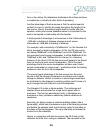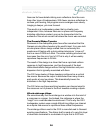
28
absolute fidelity
The Acoustic Suspension
The suspension for each loudspeaker tower comprises three
elements:
1) The neoprene vibration absorbers are tuned to isolate and
decouple the loudspeaker cabinet for optimal imaging and
bass response no matter what surface the loudspeaker sits
on.
2) The skeletal frame acts as a tuned absorber. Made of an
inch of solid acrylic, no two parts of the frame will resonate at
the same frequencies. This ensures that all midrange
frequencies are “dumped” below the base of the cabinet so
that floor-borne vibrations do not affect the imaging and
soundstage of the loudspeaker.
3) The spikes rigidly couple the suspension system to the floor.
If you have hardwood floors and do not want to make holes
in the wood, use a copper penny (instead of expensive
“spike cups”) under the spike.
A pin-point suspension system is designed to pass all
frequencies. Using a spike cup under the spike will defeat
this system. The spike passes all frequencies to the spike
cup, and then depending on the diameter of the spike cup, it
passes only frequencies below a particular frequency.
A copper penny gets deformed – the spike making an
indentation where it meets the penny, and a little “nipple” on
the other side. This still performs the same function as a pin-
point suspension system, but at the same time protects your
hardwood floor.
Nevertheless, despite the acoustic suspension, if you have a
extremely light and resonant floorboards, the acoustic suspension
may still transmit sufficient vibrations to make your floor resonate
and hence muddy up the bass and the imaging. In that case, it may
be necessary to place heavy marble, slate, or granite slabs (at
least 200lbs per slab) under the speakers. This slab serves as a
foundation on which the acoustic suspension will work.


















